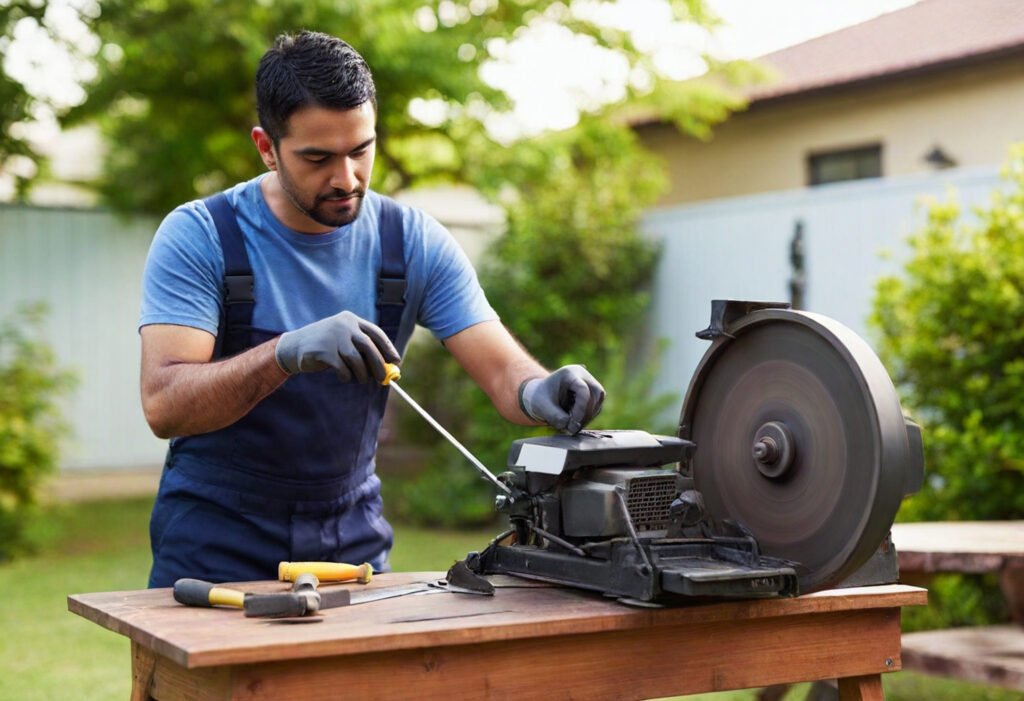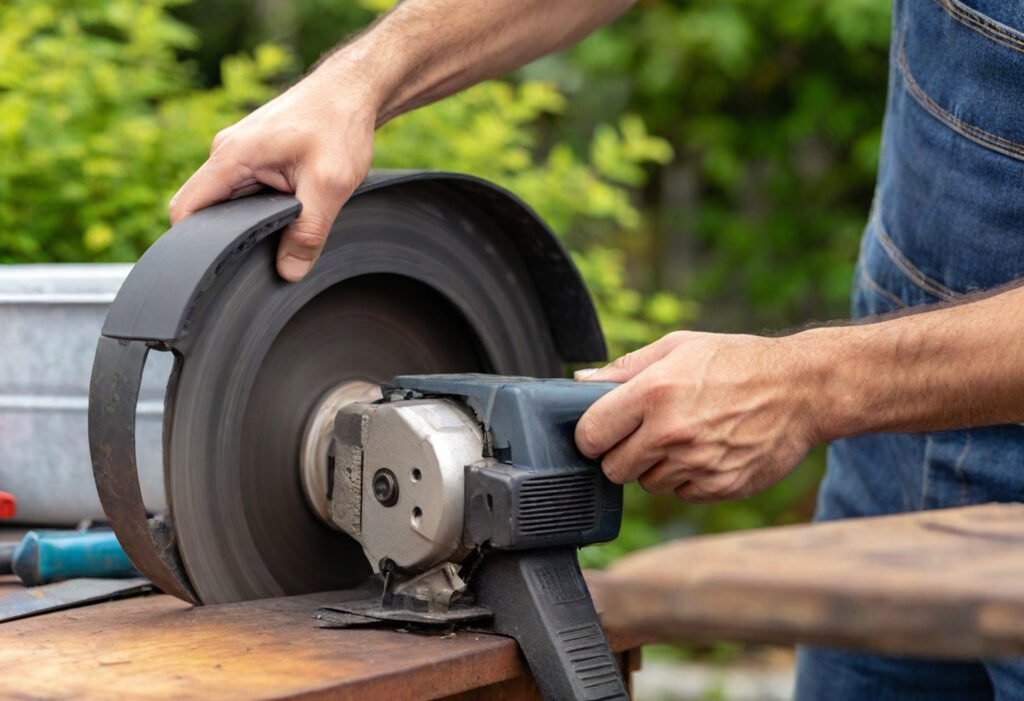Sharp mower blades play a vital role in your lawn’s health. A dull blade tears grass instead of cutting it cleanly, which weakens your lawn and creates perfect conditions for fungal growth. Many homeowners struggle to get their blade maintenance right.
Your mower blades don’t need to be as sharp as a razor. The ideal cutting edge measures between .030 inch to .045 inch. Regular home mowing typically requires just one blade sharpening session per year. The right sharpening technique at the recommended speed of 25,000 rpm makes your mower more effective and reduces the time you spend mowing.
Let us show you the quickest way to sharpen mower blades through simple steps. Our expert tips cover everything from safety measures to proper angles and blade balancing. This guide works perfectly for both newcomers and experienced mower owners who want to enhance their sharpening skills.
Safety and Setup Before Sharpening
Safety measures and a proper workspace setup are vital before you start the blade sharpening process. The right precautions will protect you from injuries and help you get the best results.
Clear the work area and remove flammable items
Pick a well-ventilated outdoor area with a stable work surface. Your blade needs a strong workbench or table as a solid foundation. The grinder should sit on a flat, level surface.
Keep your workspace free of flammable materials like shop rags, gas cans, and solvents. Sparks can ignite these items and create fire hazards. A fire extinguisher should be within reach.
No one should stand close enough to get hit by sparks or debris. You need to secure any loose clothing, hair, or objects that could catch in the grinding wheel.
Inspect the grinder and power cord
Take a good look at your grinder to spot any defects. Look for breaks in the insulation, exposed wires, or damage to the power cord’s ground terminal. The grinding stone should be free of cracks or chips, and all guards must work properly.
The grinder should stay unplugged if you notice damage to its cord, battery, or attachments. Small defects can cause serious accidents during use.
Adjust tongue and bottom guards properly
The tongue guards need correct positioning before you begin. Keep the top wheel tongue guard within ¼ inch of the stone. The bottom guard should sit no more than ⅛ inch from the stone where it meets the work table.
Here’s how to adjust these guards:
- Verify the power is off and any locks are removed
- Loosen the nuts holding the guards in place
- Slide the guard toward the stone within the proper dimension
Don’t use the grinder if you can’t get the right guard clearance or feel unsure about measurements. The blade sharpening process needs proper guard adjustment to stay safe.
How to Use a Blade Grinder for Sharpening
A properly sharpened mower blade can make all the difference to your lawn’s health. The right grinding technique helps you get professional results every time.
Identify blade orientation (left or right-handed)
You need to figure out if your blade is right-handed or left-handed:
- Put the blade flat on a surface with the bottom (grass) side down
- Point it away from you (like the 12 and 6 positions on a clock)
- Look at the far end – if the cutting edge sits on the right, it’s right-handed
Most grinders work best with right-handed blades, so check your grinder’s manual if you have a left-handed blade.
Set the correct grinding angle
The right grinding angle is vital for the best cutting performance. Standard mower blades typically need a 30-degree angle. Here’s how to set it:
- Set the blade on the grinder table
- Match its angle to the stone face – the stone should touch the grinding edge fully
- Loosen the tower nuts and adjust the screw to move the stone up or down if needed
Make sure to tighten all nuts properly after adjusting.
Secure the blade and adjust the grinder
Once you’ve set the angle, the blade needs to be clamped down firmly. The cutting edge should line up perfectly with the grinding wheel. Some specialty blade sharpeners come with preset brackets that keep the 30-degree angle automatically.
Sharpen both ends evenly
Move the blade edge back and forth on the grinding wheel with steady, light pressure. Keep the grinder moving to prevent the metal from overheating. After finishing one end, flip the blade and do the same number of passes on the other end for even sharpening.
Avoid over-sharpening the edge
The blade shouldn’t be razor-sharp – you want an edge like a butter knife. A .030-inch to .045-inch edge works best for optimal performance. Over-sharpening leads to faster dulling and creates a weaker edge that is prone to chipping. A blade that’s too sharp can fold over when it hits grass and won’t cut cleanly.
Balancing and Reinstalling the Blade

Balancing your mower blades is just as important as sharpening them. A properly balanced blade will cut down on vibration, protect your mower from damage, and make it last longer.
Use a blade balancer to check weight distribution
Your best bet to check blade balance is a purpose-made blade balancer. These cone-shaped tools give you exact measurements and reliable results. Here’s how to use one:
- Clean all grass and debris off the blade
- Set the blade horizontally on the balancer and center the hole on the cone
- Watch the blade – any tilt to one side means it’s not balanced
Don’t worry if you don’t have a balancer! A screwdriver works well as a substitute. Just put the screwdriver tip through the blade’s center hole. The blade should rest flat on the tip or handle. A dip to either side shows that the side is too heavy.
Remove excess material from the heavy side
After you spot the heavier side (the one that drops down), you’ll need to trim it down:
File or grind the heavier end with light strokes. Work on the cutting edge only and don’t remove material from the ends or blade back. Keep testing by putting the blade back on the balancer until it stays level.
Take your time and be precise – removing too much from one spot could make the other side too heavy.
Reinstall the blade securely on the mower
Clean under your mower before putting the blade back. A paint scraper or putty knife works great for scraping off stuck mud and grass. Look for the mark you made earlier that shows the blade’s bottom side.
Put the blade back with the marked side down, just like it was before. Your socket wrench should make the nut very tight for smooth operation. You don’t want to overdo it, but a loose bolt can mess up how your mower runs.
The last steps are simple – hook up the spark plug wire, add gas if needed, and take your mower outside before starting it up to avoid fumes.
Common Questions About Mower Blade Sharpening

Lawn care enthusiasts often ask about the finer points of mower blade maintenance. The right blade care can make all the difference between a lush, healthy lawn and one that struggles to thrive.
How sharp should lawn mower blades be?
You might think mower blades need razor-sharp edges, but that’s not the case. These blades should be like a butter knife – aggressively sharp but safe enough to touch without getting cut. Most manufacturers want you to maintain a 30-degree grinding angle. Razor-sharp blades create problems because they roll over when hitting grass and chip more easily. This means you’ll need more frequent sharpening and your blades won’t last as long.
How often should you sharpen mower blades?
Homeowners typically need to sharpen their blades after 20-25 hours of mowing. You can break this down by your mowing time – a 30-minute session means you can mow 40-50 times before sharpening. Another option is sharpening 1-2 times annually. Your grass will tell you when it’s time – ragged, torn tips or uneven cutting patterns signal the need for sharpening.
What tools are best for sharpening?
A dedicated blade grinder works best because it keeps consistent sharpening angles. Here are other effective options:
- Grinding wheels with built-in nylon guides
- Files for minor touch-ups
- Sharpening stones to refine edges
Many people get great results with lawn mower blade sharpening kits that include sharpeners and balancers.
When should blades be replaced?
Your blades need replacement in these situations:
- After 5-10 sharpenings
- Blade thickness drops below half an inch
- You spot cracks, missing pieces, or severe bending
- The blade makes strange noises during the operation
Most homeowners should get new blades every 1-3 years based on how much they mow.
Why is blade balance important?
Balanced blades prevent excess vibration that could damage your mower’s engine and bearings. They boost cutting performance and reduce stress on the grass. Your mower also uses less fuel because balanced blades make the engine’s job easier. Always check the balance after sharpening – unbalanced blades make your mower “vibrate like crazy” and wear out important parts faster.
Conclusion
Sharp mower blades improve your lawn’s health and appearance by a lot. This piece covers everything you need to sharpen your mower blades safely at home. Note that properly sharpened blades shouldn’t be razor-sharp but should maintain a .030 to .045-inch edge to work best.
Safety comes without a doubt first when you work with mower blades. You should always disconnect the spark plug, wear appropriate safety gear, and prepare your workspace properly before you begin.
Blade balance needs as much attention as sharpness. An unbalanced blade creates harmful vibrations that damage your mower’s engine and bearings over time. Take time to check and correct the balance after sharpening for smoother operation and longer mower life.
Your blades need sharpening once or twice annually, depending on your lawn’s size and how often you mow. Notwithstanding that, ragged grass tips signal that earlier sharpening might be needed.
This simple maintenance task saves money and ensures your lawn gets the best possible cut. Clean cuts, healthier grass, and reduced mowing time will result from your freshly sharpened blades. You’ll know exactly how to restore its cutting edge at home when your mower doesn’t handle your lawn well.


This is really helpful, must admit, it’s something I don’t do enough.